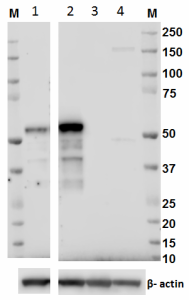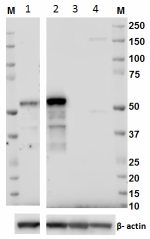- Clone
- RORg2 (See other available formats)
- Regulatory Status
- RUO
- Other Names
- RORc, Nuclear receptor ROR-gamma, Nuclear receptor RZR-gamma
- Isotype
- Armenian Hamster IgG
- Ave. Rating
- Submit a Review
- Product Citations
- publications

-

Total cell lysates (15 µg protein) from mouse thymus (lane 1, 2), mouse spleen (lane 3) and Molt-4 cells (lane 4) were resolved by electrophoresis (4-12% Bis-Tris gel), transferred to nitrocellulose, and probed with 0.5 µg/mL (1:1000 dilution, lane 1) or 2 µg/mL (1:250 dilution, lane 2, 3, 4) of purified anti-RORγ antibody, clone RORg2 (upper panel). Proteins were visualized by chemiluminescence detection (Cat. No. 426303) using 1:3000 diluted anti-hamster-IgG secondary antibody conjugated to HRP for purified anti-RORγ antibody or 1:10000 diluted Direct-Blot™ HRP anti-β-actin antibody, clone W16197A (lower panel). Lane M: Molecular weight ladder.
| Cat # | Size | Price | Quantity Check Availability | Save | ||
|---|---|---|---|---|---|---|
| 646501 | 25 µg | $147 | ||||
| 646502 | 100 µg | $323 | ||||
RORγ (Retinoid-related orphan receptor gamma) belongs to nuclear hormone receptor family, NR1 subfamily. RORγ has two isoforms: RORγ1 and RORγ2 (also known as RORγt). RORγ1 contains 516 amino acids and RORγt contains 495 amino acids (RORγt lacks the amino terminus). RORγ1 is expressed in thymus, kidney, liver, muscle and brown fat tissue but not white fat tissue. RORγt is specifically expressed in CD4+/CD8+ thymocytes and lymphoid tissue inducers (LTi). RORγ plays critical roles during thymopoiesis, T cell homeostasis, lymph nodes and Peyers patch development. Among two isoforms, RORγt is well studied and it promotes thymocyte differentiation into pro-inflammatory Th17 cells.
Product DetailsProduct Details
- Verified Reactivity
- Mouse
- Antibody Type
- Monoclonal
- Host Species
- Armenian Hamster
- Immunogen
- Mouse RORγ
- Formulation
- Phosphate-buffered solution, pH 7.2, containing 0.09% sodium azide.
- Preparation
- The antibody was purified by affinity chromatography.
- Concentration
- 0.5 mg/ml
- Storage & Handling
- The antibody solution should be stored undiluted between 2°C and 8°C.
- Application
-
WB - Quality tested
- Recommended Usage
-
Each lot of this antibody is quality control tested by Western blotting. For Western blotting, the suggested use of this reagent is 0.5 - 2.0 µg per ml. It is recommended that the reagent be titrated for optimal performance for each application.
-
Application References
(PubMed link indicates BioLegend citation) -
- Sun Z, et al. 2000. Science 288:2369
- Product Citations
-
- RRID
-
AB_2180302 (BioLegend Cat. No. 646501)
AB_2238503 (BioLegend Cat. No. 646502)
Antigen Details
- Structure
- RORγ has two isoforms: RORγ1 and RORγ2 (also known as RORγt). RORγ1 contains 516 amino acids and RORγt contains 495 amino acids (RORγt lacks the amino terminus).
- Distribution
-
RORγ1 is expressed in thymus, kidney, liver, muscle and brown fat tissue but not white fat tissue. RORγt is specifically expressed in CD4+/CD8+ double positive thymocytes, Th17 cells and lymphoid tissue inducers (LTi).
- Function
- RORγ plays critical roles during thymopoiesis, T cell homeostasis, lymph nodes and Peyers patch development. Among two isoforms, RORγt is well studied and it promotes thymocyte differentiation into pro-inflammatory Th17 cells.
- Cell Type
- Thymocytes
- Biology Area
- Cell Biology, Immunology, Transcription Factors
- Molecular Family
- Nuclear Markers
- Antigen References
-
1. Medvedev A, et al. 1997. Genomics 46:93.
2. He YW, et al. 1998. Immunity 9:797.
3. Eberl G, et al. 2004. Nat. Immunol. 5:64. - Gene ID
- 19885 View all products for this Gene ID
- UniProt
- View information about RORgamma on UniProt.org
Related Pages & Pathways
Pages
Related FAQs
Other Formats
View All RORγ Reagents Request Custom Conjugation| Description | Clone | Applications |
|---|---|---|
| Purified anti-RORγ | RORg2 | WB |
Compare Data Across All Formats
This data display is provided for general comparisons between formats.
Your actual data may vary due to variations in samples, target cells, instruments and their settings, staining conditions, and other factors.
If you need assistance with selecting the best format contact our expert technical support team.
-
Purified anti-RORγ

Total cell lysates (15 µg protein) from mouse thymus (lane 1...
 Login/Register
Login/Register 







Follow Us